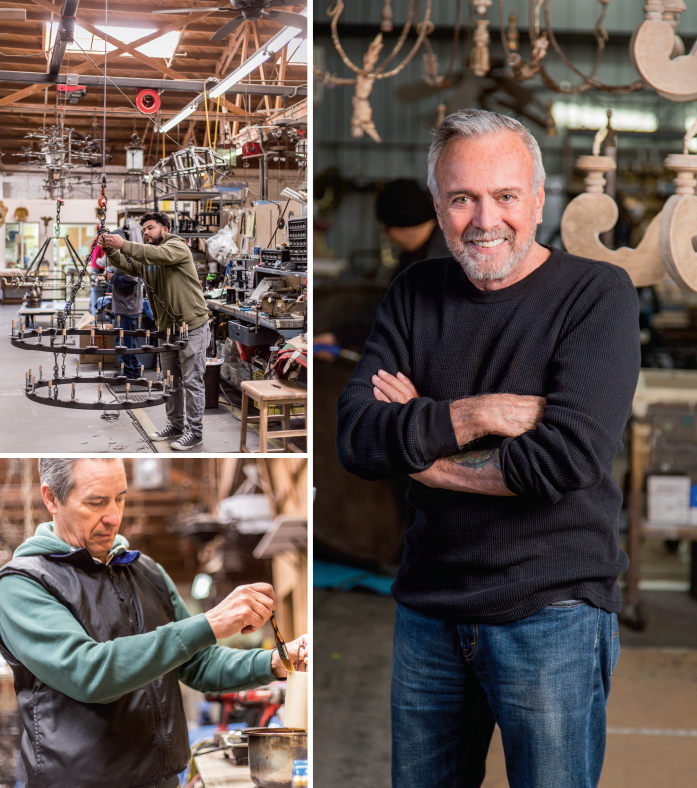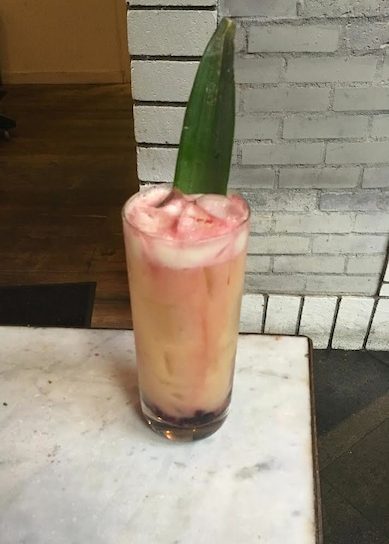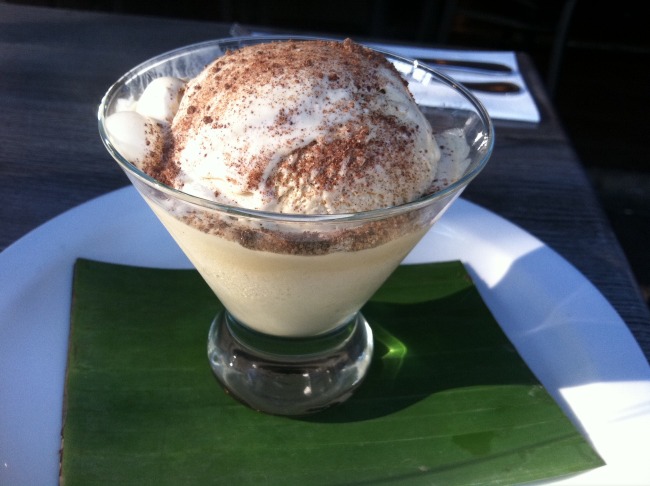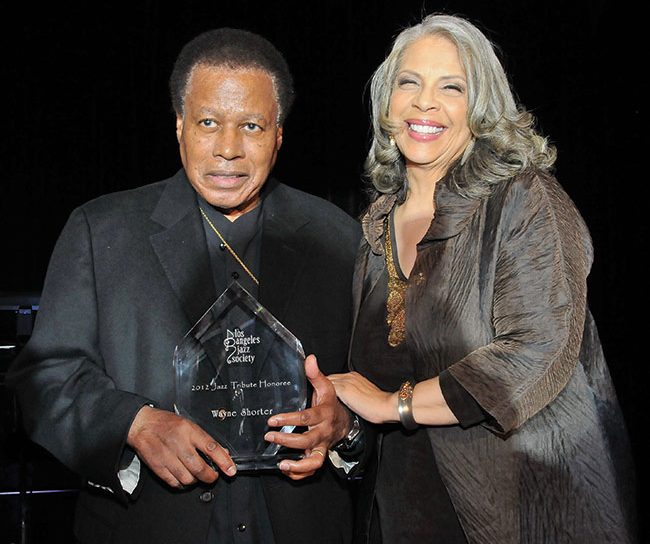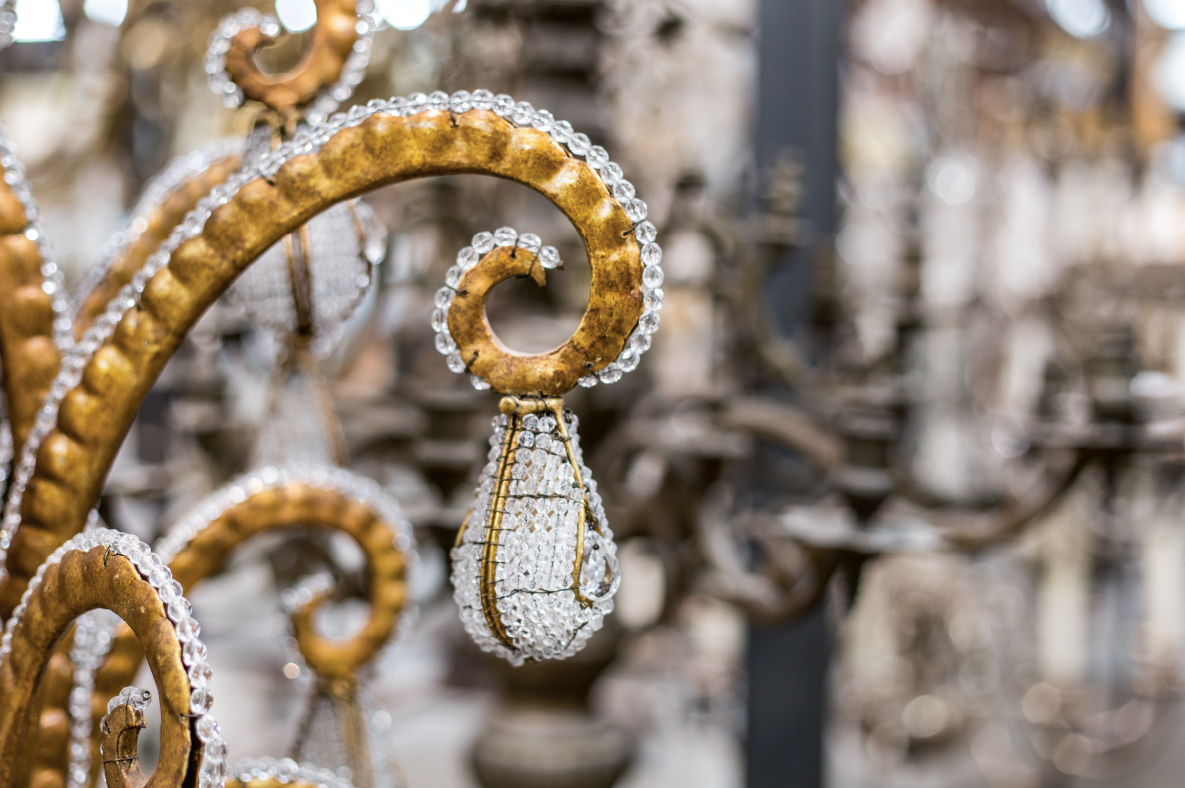
Divine Light
For over half a century Paul Ferrante has created custom, high-end lighting fixtures.
-
CategoryPeople
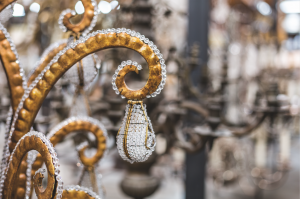 From the 28 vintage-inspired wrought iron and glass lanterns that illuminate the Ojai Valley Inn’s iconic 200-year old oak tree to the Queen Anne chandelier suspended from the ceiling of a hillside home on Majorca, some of the most exquisite lighting fixtures in the world are handcrafted at the Paul Ferrante factory in Culver City.
From the 28 vintage-inspired wrought iron and glass lanterns that illuminate the Ojai Valley Inn’s iconic 200-year old oak tree to the Queen Anne chandelier suspended from the ceiling of a hillside home on Majorca, some of the most exquisite lighting fixtures in the world are handcrafted at the Paul Ferrante factory in Culver City.
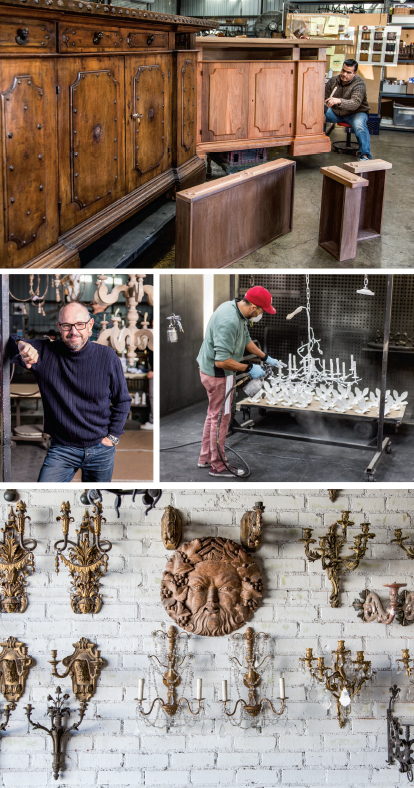 Early weekday mornings, well before the 405 freeway becomes gridlocked, Elizabeth Kaplan of Valley Village and Alex Menegaz of Studio City make the trek to Paul Ferrante’s 28,000-square-foot factory. At the bustling site, the pair has been instrumental in running the business for over two decades.
Early weekday mornings, well before the 405 freeway becomes gridlocked, Elizabeth Kaplan of Valley Village and Alex Menegaz of Studio City make the trek to Paul Ferrante’s 28,000-square-foot factory. At the bustling site, the pair has been instrumental in running the business for over two decades.
By the time they arrive about 7 a.m., artisans are already at work—meticulously creating made-to-order fixtures and one-of-a-kind, handmade custom pieces for the design industry’s discerning elite.
On any given day you might find a painter delicately gold leafing a nearly six-foot-long hanging fixture shaped like a tree branch, a glasscutter working on panes of a “St. Tropez” hanging lantern or a craftsman stringing crystals on a “Valentina” chandelier.
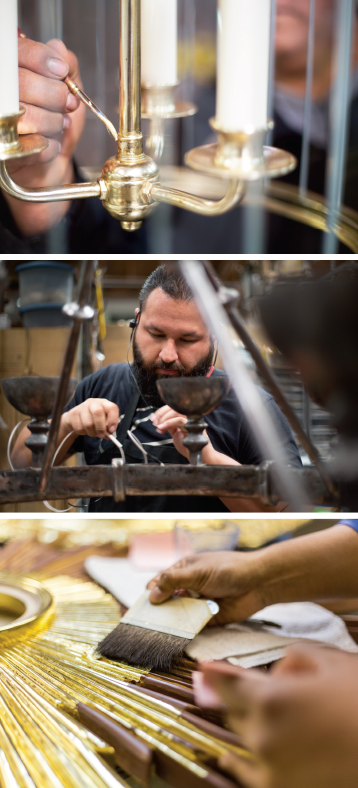 Depending on the complexity, each piece takes between three and six pairs of hands and 10 to 14 weeks from the time it’s ordered to the time it’s ready to be shipped somewhere fabulous. Achieving just the right aesthetic requires a specific recipe of multilayered paint, rubs and other finishing techniques, none of which are actually written down.
Depending on the complexity, each piece takes between three and six pairs of hands and 10 to 14 weeks from the time it’s ordered to the time it’s ready to be shipped somewhere fabulous. Achieving just the right aesthetic requires a specific recipe of multilayered paint, rubs and other finishing techniques, none of which are actually written down.
“They’re all in the guys’ heads,” says Alex. New artisans apprentice for years to master the necessary skills and formulas. Luckily most employees stay a long time. Several are also related. The team includes three sets of brothers and three sets of cousins, with duties ranging from painting to electrical work.
Only the finest materials are used. Jumbo chain links and paper candle sleeves are imported from France. Toward the center of the factory, hundreds of extraordinary lighting fixtures hang from special rigs. Among these are samples from the company’s ever-expanding line, as well as authentic antiques.
Some of the antiques are sold at Paul Ferrante’s renowned showroom on Melrose Place, which is currently closed for a complete renovation. It’s slated to reopen in April, just in time for the company’s 60th anniversary. Other vintage pieces serve as reference models to ensure authenticity in creating reproductions.
“I could have sold some of these antiques 10 times over, but they’re more valuable as a reference,” explains Alex, who oversees production. “This way I have a side-by-side comparison.”
Company chief Tommy Raynor procured many of the antiques over decades of buying trips to Europe. At 85, Tommy, a longtime business partner of the company’s late founder and namesake, Paul Ferrante, still runs the show with help from his family.
Elizabeth is actually Tommy’s niece. Her mom (Tommy’s sister) Grace Saroyan and another of Grace’s daughters, Julie Urbanek, are also key players. Grace and Julie oversee sales, and Elizabeth handles the business side. Grace and Julie spend most of their time at the Pacific Design Center in West Hollywood, one of several showrooms across the country where Paul Ferrante wares are sold exclusively to the trade.
“We’re an Italian family, so were very vocal and very loud at times,” admits Elizabeth. “There’s a lot of screaming, but we don’t think we’re screaming. At the Melrose Place showroom, we’d be screaming across the showroom. Customers would look, then we’d say ‘Oh it’s okay. We’re family.’”
It was actually Grace who convinced her brother to venture into manufacturing his own designs.
Tommy joined Ferrante, who died in 1994, in the late 1950s. Back then the company sold antiques and specialized in rewiring antique objects into custom lamps. The original showroom was on La Cienega Blvd., before moving to Melrose Place and helping to establish the street as an international design destination.
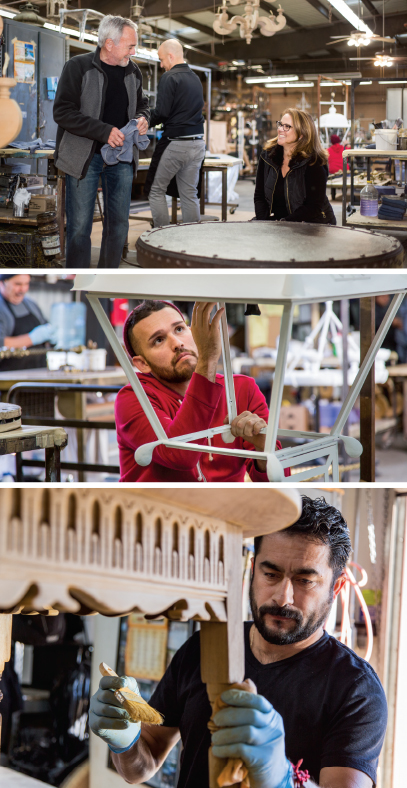
Tommy’s knack and love of design were apparent early on.
“Growing up I’d come home and the living room would be different,” recalls Elizabeth. “My uncle would have found two great chairs that he thought my mom would like. He’d bring them over and then he’d be like, ‘Oh, you need a new table,’ and out would go the old table.”
Tommy’s first two original pieces for Paul Ferrante were the “Knuckle” sconce and “Windsor Wall” lantern. The collection now boasts over a thousand different items, including gold-leaf candelabras, double-tiered, bronze chandeliers and hanging iron pendants.
Though the majority of designs are considered traditional, styles run the gamut. Last year Architectural Digest named Paul Ferrante’s modern, plaster-white Marina chandelier with sprouting blossoms one of “15 Must-Have Products.”
“There is no one source for inspiration. I look at everything,” explains Tommy.
Lighting accounts for 75% of sales. Furniture and accent pieces represent the other 25%. In addition, the company provides its unparalleled expertise and craftsmanship to build one-of-a-kind creations envisioned by top designers and architects for their discriminating clients.
LA designer Joan Behnke tapped the Ferrante team to build custom glass and wrought iron lanterns for supermodel Gisele Bündchen and quarterback Tom Brady’s former Brentwood estate.
When the legendary Cloister at Sea Island Resort in Georgia underwent a $40 million renovation in 2006, designers turned to Paul Ferrante to construct custom chandeliers for the lobby. The three-tiered, crystal-adorned creations measured 136 inches in diameter. Although the finished pieces were spectacular, Alex recalls, “We realized they were too big to get out of the factory. The doors weren’t big enough.”
Catastrophe was averted when Alex had the chandeliers split into three sections and then reassembled outside.
Clients have come to expect nothing less than such perfection.
“They know with us they’re going to get superb quality and customer service,” says Elizabeth of the company’s longevity and success.
Achieving this is due in no small part to the pervasive pride and family culture that extends beyond bloodlines. Not only does management eschew formal titles, they don’t believe in time cards either. Employees routinely cook up feasts for the entire team while a group of 20 exercises together at lunch, running the Culver City stairs. And everyone leaves at 3:30 p.m.
“It keeps people happy,” says Alex “to get home in time to have dinner with their kids.”
